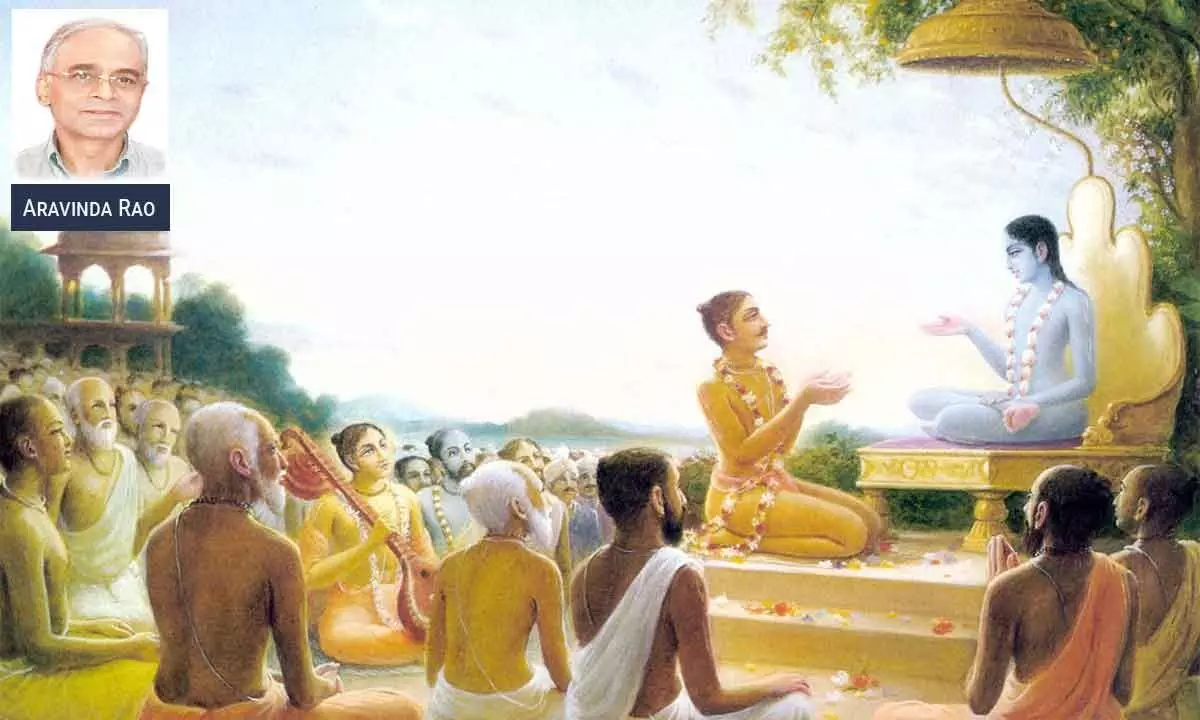Live
- Allu Arjun’s house attacked by protesters demanding compensation for the stampede victim
- Several Gulf countries impose visa ban on Pakistanis over their involvement in crime, fraud and begging
- Public outrage in Jharkhand's Giridih over murder, police station gheraoed
- Santosh Trophy: Meghalaya edge Goa 1-0 to secure QF berth
- Army's swift action prevented Kolkata fire from spreading: Defence Ministry
- State Police tried to murder Ravi- Union minister
- FDI flow into India from Gulf countries surges to $24.54 bn in 12 years
- BBL: McSweeney hits fiery 78 to guide Heat to thrilling win after Australia snub
- 'Exceptional case..': Delhi HC orders revision of CLAT-2025 results
- South Korea reports new avian influenza case at regional farm
Just In
Social Consciousness: Art – An aid in spiritual journey


A unique feature of Indian tradition is that art, in its several forms, flourished as a handmaid of spirituality. Art is a more effective tool for attaining purity of mind, compared to karma yoga, the yoga of self-restraint etc., told in the Gita. It touches the heart, whereas all others touch the mind. Srimad Bhagavatam is the greatest example of this
A unique feature of Indian tradition is that art, in its several forms, flourished as a handmaid of spirituality. Art is a more effective tool for attaining purity of mind, compared to karma yoga, the yoga of self-restraint etc., told in the Gita. It touches the heart, whereas all others touch the mind. Srimad Bhagavatam is the greatest example of this. Vyasa formulated that the itihasas and the Puranas were meant to train a person in the spiritual journey. Later, classical poetry of great poets was also included in this scheme. The difference was only in tone. The Vedas spoke like a father to son, and the itihasas and Puranas counselled like a friend, giving live examples describing the sufferings of noble people like Rama, Sita or Dharmaraja. They illustrated how great persons faced adversities but upheld dharma. Great poetry is advised sweetly like a wife would persuade her husband. Poetry was expected not only to please but to enlighten. It was so even in Greek literature, where Aristotle said that a good work of art had to produce catharsis, a purging of emotions and feelings.
A work of art is a combination of language appropriate to the theme or characters, figures of speech, suggested meanings, and a dominant sentiment, called rasa, which has to be felt and savoured. The human situation described in the text creates this rasa in the audience’s mind. The reader or the audience would be enriched after reading the text or witnessing a play. This applies to a work of art in any form, such as drama or a film, in the modern context.
Technology can enhance the message of art and make it more effective. It does not contradict the human element in any way. However, while making a film, if there is ignorance of the original work or indifference and over-reliance on technology, the product will remain a work of art. This underlines the continuing need of people who know the texts from tradition. A feature film on a great work of art, like the Ramayana or the Mahabharata, may have great graphics or visual effects and enthral the audience. But this thrill is momentary if the human element is missing and the ethical debates are not portrayed. There may be no take-home message, no purification of feelings, no joy of understanding, and no ennobling of emotions, except the thrill of graphics. Adults are reduced to kids watching video games.
Literary critics compared the joy of understanding great literature with the bliss of self-realization. Experience of rasa results when we unconsciously identify with the protagonist or the characters therein. We share their emotions and anxieties; we feel anguished when Sita is tormented, we take the position of Sita and question Rama too, we debate on the ethical issues in the Mahabharata and the process our actions in our daily life would also attain perfection. This leads to purification of our emotions, which is the precondition for spiritual progress, as we see in the Gita.
Classics have universal appeal. They make sense now and can guide us now. Fortunately, all our texts are available in all modern Indian languages and English. All we need to do is to go to them respectfully. A great responsibility lies in the young parents to become aware of these treasures and prevent vulgarising of the next generation by ignorant dream merchants.
(Writer is former DGP, Andhra Pradesh)

© 2024 Hyderabad Media House Limited/The Hans India. All rights reserved. Powered by hocalwire.com






